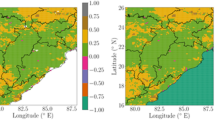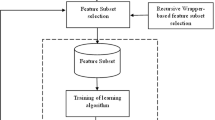Abstract
Natural disasters like bushfires pose a catastrophic threat to the Australia and the world’s territorial areas. This fire spreads in a wide area within seconds, and therefore, it is complicated and challenging to mitigate. To minimize risk and increase resilience, identifying bushfire occurrences beforehand and takes necessary actions is critically important. This study focuses on using deep learning technology for predicting bushfire occurrences using real weather data in any given location. Real-time and off-line weather data was collected using Weather Underground API, from 2012 to 2017 (\(N= 128{,}329\)). The obtained weather data are temperature, dew point, pressure, wind speed, wind direction, humidity, and daily rain. An algorithm was developed to collect this data automatically from any destination. Six different optimizer models were analyzed that use in deep learning technology. Then, the comparison was carried out to identify the best model. Selecting an optimizer for training the neural network, in this case, deep learning is a challenging task. Six best optimizers were chosen to compare and identify the best optimizer to estimate potential fire occurrences in given locations. The six optimizers; Adagrad, Adadelta, RMSprop, Adam, Nadam, and SGD were compared based on their processing time, prediction accuracy and error. Our findings suggest Adagrad optimizer provides less prediction time which is a critical factor for fast-spreading bushfires. Our work provides a data collection model for disaster prediction, which could be utilized to collect climatic characteristics and topographical characteristics in with larger samples. The developed methodology could be utilized as a natural disaster prediction model for precise predictions with less error and processing time using real-time data. This study provides an enhanced understanding of finding the locations that fire starts or spot fires which are more likely to occur, and lead to identifying of fire starts that are more likely to spread.
Graphic abstract






Similar content being viewed by others

References
Dozat T (2016) Incorporating nesterov momentum into adam. In: Fourth international conference on learning representations (ICLR), Puerto Rico
Duchi J, Hazan E, Singer Y (2011) Adaptive subgradient methods for online learning and stochastic optimization. J Mach Learn Res 12:2121–2159
Dutta R, Das A, Aryal J (2016) Big data integration shows australian bushfire frequency is increasing significantly. R Soc Open Sci 3(2):150241
Elia M, Giannico V, Lafortezza R, Sanesi G (2019) Modeling fire ignition patterns in mediterranean urban interfaces. Stoch Environ Res Risk Assess 33(1):169–181
Field CB, Barros V, Stocker T, Dahe DDQ, Ebi K, Mastrandrea M, Mach K, Plattner G, Allen S, Tignor M, Midgley P (2012) Managing the risks of extreme events and disasters to advance climate change adaptation (srex). A special report of working groups I and II of the intergovernmental panel on climate change (IPCC). Technical report
Finney MA, McHugh CW, Grenfell IC, Riley KL, Short KC (2011) A simulation of probabilistic wildfire risk components for the continental united states. Stoch Environ Res Risk Assess 25:973–1000
Fukutani Y, Suppasri A, Imamura F (2015) Stochastic analysis and uncertainty assessment of tsunami wave height using a random source parameter model that targets a tohoku-type earthquake fault. Stoch Environ Res Risk Assess 29:1763–1779
Halgamuge MN, Nirmalathas A (2018) Analysis of large flood events for disaster risk reduction: based on flood data during 1985–2016 in Australia and India. Int J Disaster Risk Reduct 24:1–11
Khastagir A (2017) Fire frequency analysis for different climatic stations in Victoria, Australia. Nat Hazards 93(2):787–802
Nesterov Y (2012) Efficiency of coordinate descent methods on huge-scale optimization problems. SIAM J Optim 22(2):341–362
Nishino T (2019) Physics-based urban fire spread simulation coupled with stochastic occurrence of spot fires. Stoch Environ Res Risk Assess 33(2):451–463. https://doi.org/10.1007/s00477-019-01649-3
Qin XALCY, Yang W (2018) Fault tolerant storage and data access optimization in data center networks. J Netw Comput Appl 113:109–118
Robbins H, Monro S (1951) A stochastic approximation method. Annals Math Stat 22(3):400–407. http://www.jstor.org/stable/2236626
Saeedian P, Moran B, Tolhurst K, Halgamuge MN (2010) Prediction of high-risk areas in wildland fires. In: Fifth international conference on information and automation for sustainability (ICIAfS’10), Colombo, Sri Lanka, pp 399–403
Sutskever I (2013) Training recurrent neural networks. Ph.D. dissertation, University of Toronto, Toronto, Canada
Underground W (2019) Weather forecast and reports—long range and local
World Health Organization (2013) Climate change and health. https://www.who.int/en/news-room/fact-sheets/detail/climate-change-and-health
Yang WCS, He H, Wang L (2018) Direct tangible damage assessment for regional snowmelt flood disasters with HJ-1 and HR satellite images: a case study of the Altay region, Northern Xinjiang, China. Nat Hazards 94(164):1099–1116
Yuan X, He P, Zhu Q, Li X (2019) Adversarial examples: attacks and defenses for deep learning. IEEE Trans Neural Netw Learn Syst 30(9):2805–2824
Zeiler MD (2012) ADADELTA: an adaptive learning rate method. arXiv
Zhang Q, Cui L, Zhang J, Liu X, Tong Z (2015) Grid based dynamic risk assessment for grassland fire disaster in Hulunbuir. Stoch Environ Res Risk Assess 29:589–598
Author information
Authors and Affiliations
Corresponding author
Additional information
Publisher's Note
Springer Nature remains neutral with regard to jurisdictional claims in published maps and institutional affiliations.
Rights and permissions
About this article
Cite this article
Halgamuge, M.N., Daminda, E. & Nirmalathas, A. Best optimizer selection for predicting bushfire occurrences using deep learning. Nat Hazards 103, 845–860 (2020). https://doi.org/10.1007/s11069-020-04015-7
Received:
Accepted:
Published:
Issue Date:
DOI: https://doi.org/10.1007/s11069-020-04015-7



